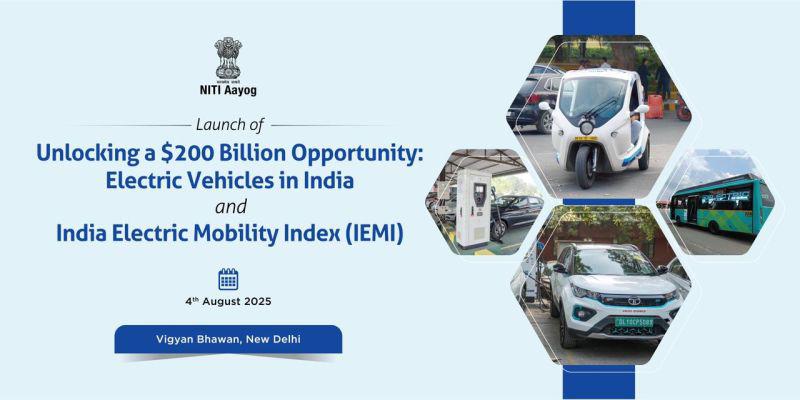 Image Source: LinkedIn
Image Source: LinkedIn
NITI Aayog has launched a comprehensive and timely report titled “Unlocking a $200 Billion Opportunity: Electric Vehicles in India,” outlining the strategic roadmap to accelerate India’s transition to electric mobility by 2030. The report highlights current challenges, opportunities, and a series of actionable recommendations designed to propel India towards its ambitious goal of achieving a 30% share of electric vehicles (EVs) in total vehicle sales by the end of the decade.
Key Highlights: A Transformative Shift in Clean Mobility
The report was released by Shri Rajiv Gauba, Member of NITI Aayog, in the presence of key dignitaries including Shri B. V. R. Subrahmanyam, CEO of NITI Aayog, Shri Kamran Rizvi, Secretary of the Ministry of Heavy Industries, and Shri O. P. Agarwal, Distinguished Fellow at NITI Aayog.
India’s EV sales have surged from 50,000 units in 2016 to over 2.08 million in 2024, but the pace remains modest compared to the global increase from 918,000 to 18.78 million units during the same period.
The country’s EV penetration was approximately one-fifth of global levels in 2020 but rose to more than two-fifths in 2024, signaling a positive trend yet underscoring the need for accelerated growth.
India aims to capture a 30% market share of electric vehicles in all vehicle sales by 2030, aiming to unlock a $200 billion ecosystem around EV manufacturing, ancillary industries, and services.
Strategic Roadmap and Recommendations
The report enumerates key barriers including high upfront vehicle prices, limited financing options, underdeveloped charging infrastructure, fragmented state policies, and lack of consumer awareness about total cost of ownership.
It advocates a shift from reliance purely on subsidies to a holistic strategy combining regulatory mandates, innovative financing, and robust infrastructure development.
A vital recommendation includes scaling up public charging and battery swapping infrastructure, with targets such as deploying around 88,500 charging and swapping stations under the PM E-DRIVE program, ensuring urban grids have stations every 3 km and highways every 25 km.
The report emphasizes the need for standardized data collection, including vehicle registrations and battery identification, to support market transparency, track performance, enable recycling, and foster investor confidence.
Strengthening supply chains and domestic manufacturing, particularly for critical components and batteries, is urged to reduce dependence on imports and build a resilient EV ecosystem.
Sectoral Insights and Challenges
India has emerged as a leader in the electric three-wheeler segment and has made significant progress in two-wheelers and electric buses.
However, electric cars and trucks face slower adoption due to higher capital costs and financing challenges, with electric trucks costing two to three times more than diesel equivalents and facing loan interest rates as high as 18%.
Charging infrastructure is crucial but faces hurdles such as poor location planning, low utilization rates, and GST-related cost increments of 18% on public charging services.
The report calls for enhanced awareness campaigns to educate consumers on the lifetime cost benefits of EVs beyond upfront expenses.
Collaborative and Data-Driven Approach
Developed through extensive consultations across seven dedicated stakeholder meetings held at NITI Aayog, the report advocates for cross-sector collaboration between government, industry, finance, and research institutions.
It proposes unified national-level governance frameworks supported by data analytics and real-time monitoring to ensure policy coherence across states and central agencies.
The blueprint also aligns with India’s environmental commitments, aiming to reduce petroleum imports and curb greenhouse gas emissions by electrifying the transportation sector.
Immediate Next Steps and Policy Alignment
The report identifies immediate actionable steps including enhancing incentives for electric buses and commercial vehicles, streamlining regulations, expanding credit facilities tailored to fleet operators, and accelerating rollout of charging infrastructure.
It acknowledges the ongoing transition from FAME II subsidies to PM E-DRIVE framework, with proposed FAME III focusing on rural infrastructure and fleet electrification through a ₹15,000 crore allocation till 2030.
The future strategy balances sustaining growth momentum with financial sustainability and market competitiveness.
Conclusion: Paving the Path to a $200 Billion EV Ecosystem
NITI Aayog’s report offers a data-driven, comprehensive blueprint for India’s electric vehicle revolution, emphasizing strategic unlocking of key levers to realize a $200 billion opportunity by 2030. By overcoming structural barriers through coordinated policy, infrastructure scale-up, financing innovation, and consumer engagement, India aims to become a global leader in clean mobility. This transition promises to enhance energy security, environmental sustainability, and economic growth, making electric vehicles a central pillar of India’s clean energy future.
Sources: Press Information Bureau India, DD News, Down To Earth
Advertisement
Advertisement




